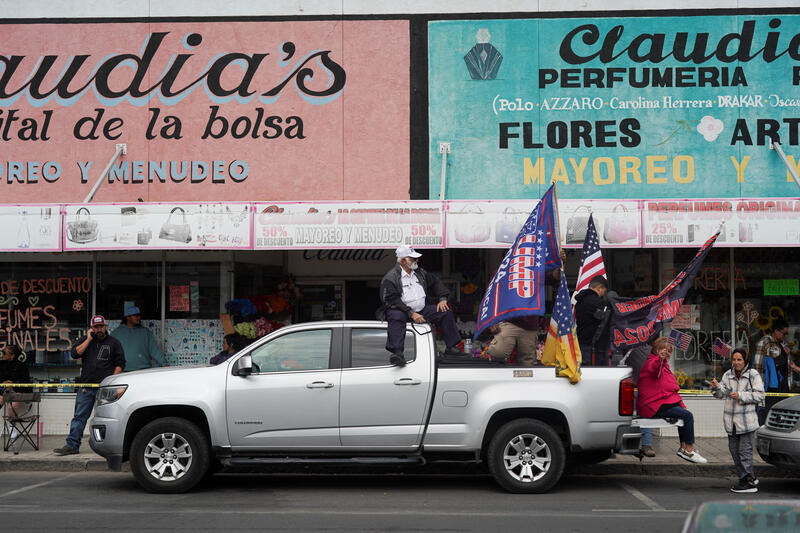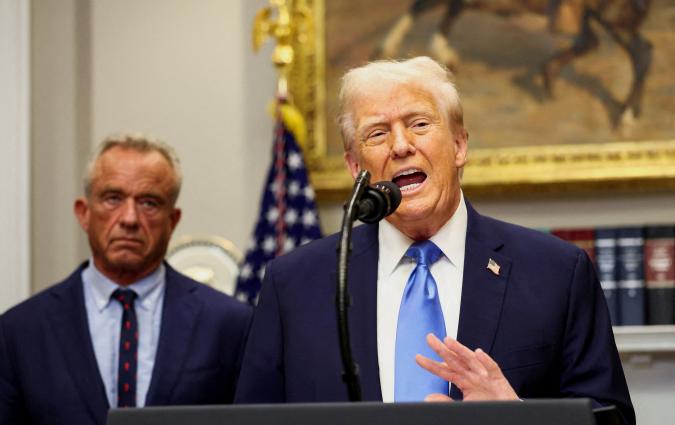AI, lies and conspiracy theories: How Latinos became a key target for misinformation in the US election

Supporters of Republican presidential candidate and former U.S. President Donald Trump gather outside Shelby Park on the day he visits the U.S.-Mexico border at Eagle Pass, Texas, U.S., February 29, 2024. REUTERS/Go Nakamura
Is Taylor Swift a Pentagon psychological operations asset? Did Texas governor Greg Abbott say that Joe Biden needs to learn from Vladimir Putin to work for the interest of the United States? Did Donald Trump say that the 9/11 attacks were an inside job of the US government? Has the US military arrived in Ecuador to ‘kill terrorists’?
If you scroll through Spanish-language TikTok, X, and Facebook, you may have seen some of these falsehoods that aim to negatively portray Democrats or Republicans, depending on which fake news you encounter.
US voters will head to the polls on 5 November in the first presidential election since the rise of generative AI. Audiences might be exposed to audio, images and videos created with Midjourney, Dall-E, ChatGPT and other tools. But they will definitely encounter more traditional forms of misinformation, which tend to be based on true information that’s spun, twisted, recontextualised, or reworked by activists and campaigners with the goal of reinforcing partisan narratives, just as the stories above show.
Throughout the past couple of decades, US Latinos have been the target for these kinds of mis- and disinformation campaigns. With an estimated 36.2 million of Latinos being eligible to vote in 2024, up from 32.3 million in 2020, they make up the biggest minority group in the country with a significant say on its future, as many live in battleground states such as Florida, Arizona, Nevada, and Georgia.
To understand what narratives are being disseminated to Spanish-speakers in the US, I spoke to three experts who are tracking them and fact-checking them to Spanish-speaking audiences.
How Latinos are targeted
Tamoa Calzadilla is the editor-in-chief of Factchequado, a digital fact-checking outlet focusing on disinformation in Spanish in the United States. She stresses that US Latinos are not a monolith voting group and explains that different narratives target different communities depending on where you come from.
“I live here in a community in Miami with many Venezuelans and many Cubans who are afraid of dictatorships and socialism. Some conspiracy groups know this and then they use it to scare people,” Calzadilla says.
A good example is a YouTube campaign ad that the Trump campaign created in 2020 falsely claiming that the Venezuelan government supported Joe Biden. According to nonprofit newsroom ProPublica, the video was watched more than 100,000 times in Florida in the nine days leading up to the 2020 presidential election. Venezuelan president Nicolás Maduro didn’t endorse any of the candidates. But some voters may have believed what they saw.
Other narratives that prey on Latino communities have to do with inflation (targeted at Argentinians and Venezuelans), abortion and reproductive rights (most Latin Americans are Catholic), and the shadow of electoral fraud or rigged elections (something that has happened in the past in Honduras, Nicaragua, Ecuador, and many other countries).
“This kind of disinformation is targeted at the Latino community who don’t speak English,” says Calzadilla. “We understand that Spanish speakers in the United States are more vulnerable than others because they do not have the same sources [as English speakers] to inform themselves.”
While many young Latinos consume news in English, over 15 million American households are Spanish-speaking, and at least three million of those households are “limited English speaking,” according to the Census Bureau’s American Community Survey. This means that a significant portion of the Latino population in the US consumes Spanish-language content.
Sam Woolley, director of the propaganda research lab at the Center for Media Engagement at the University of Texas, has also seen these narratives adapt towards particular populations. The Center, which has worked with multiple and diverse Latino communities across the US, looks at how this segment of the population is exposed to manipulative content.
“One critical thing to understand is that a lot of the campaigns we see are micro-targeted at specific subsections of the Latino population in specific geographies and they speak about issues that are specifically relevant to those communities,” he explains.
Some narratives, however, transcend sub-communities to target the wider Spanish-speaking electorate. According to Calzadilla, one of the most prominent ones is the alleged electoral fraud in 2020 and the so-called illegal migrant invasion. Ronny Rojas who leads Tverifica, Telemundo’s fact-checking initiative, agrees and says he’s often seen immigration messages, including some using false or misleading data to draw a link between increased immigration and criminality. While a number of Latinos in the US are immigrants themselves or come from immigrant families, many of them oppose what they see as the onslaught of illegal immigration coming from the southern border. “There’s a lot of rejection from at least a part of the Latino community towards this type of migration,” he explains. “We are seeing that now because the issue of migration has become a central point in this campaign.”
He speculates that these narratives are not just created to persuade voters but to create confusion amongst them. “By generating more confusion, it adds to the discussions about immigration,” Rojas says. “The strongest narratives in the last few years are that migrants exploit the benefits system, which is not the case.”
Who spreads these false narratives?
As the Republican primary was starting to heat up in 2023, Ron DeSantis’ campaign shared a video criticising Trump for not firing Anthony Fauci from his role in the COVID-19 taskforce. The video included fake AI-generated images of Trump hugging and kissing Fauci. While this example and the one above connecting Maduro to Biden come directly from the Republican camp, can we say that Republicans are more likely to spread disinformation to Latinos than Democrats? Not necessarily, but it manifests in different ways, Caldazilla says.
“Some conservative media outlets and radio stations in Miami spread conspiracy theories like the great replacement theory that says there is a plot to bring immigrants to vote and the ‘big lie’ [saying Trump won the 2020 election],” she says. “[Democrats] exaggerate how successful their administration is, but we are not seeing a lot of use of artificial intelligence to deceive people about a specific conspiracy theory.” She says that Democrats are more likely to omit information that makes them look bad or inflate figures that make them look good, whereas Republicans are more likely to reference conspiracy theories.
Woolley agrees that both parties are leveraging different tactics on social media to try to manipulate public opinion. He further explains the Democrats’ general strategy, which involves the use of coordinated groups of political influencers who are paid to riff off a script without any disclosures. While Republicans also employ coordinated influencer campaigns, they are more willing to use botnets and disinformation to sway people’s perspectives.
While the origin of some of these lies is easy to track as they come from candidates themselves, most of the time it’s not so cut and dry. Woolley says that campaigns often engage in what he calls ‘identity laundering’, with shadowy marketing firms often purposely created to just work during one election in one state for a specific campaign.
“It is important for people to understand that it's often intermediaries and consulting groups that are doing this work,” Woolley explains. “The United States still has several loopholes that allow campaigns to hire contractors, but then the contractors can hire subcontractors that can avoid having to list themselves as having worked for a political campaign.”
What’s new in the age of AI?
Woolley and his colleagues at the Center for Media Engagement have been tracking what they call computational propaganda (bots, algorithms and other forms of automation) since 2012. While the bot driven disinformation campaigns they saw in 2016 were rudimentary and repetitive, they still managed to manipulate algorithms and spread false and harmful content during the campaign.
“What generative AI does is putting computational propaganda on steroids,” Woolley says. “With generative AI, campaigns are not only amplified to a higher degree. They're also much more persuasive, and much more nuanced.”
What does Woolley mean by this? As a social scientist who has studied computational manipulation in the political sphere for years, he often has trouble identifying images that have been doctored by AI. “If experts cannot distinguish between AI-created content, whether it's images, text, videos, and non-generic content, then what hope do regular voters have?” he says.
One of the fact-checking initiatives from Telemundo’s Tverifica is a WhatsApp channel where they can communicate directly with their audience. This service also allows users to send the team story ideas, and images and documents they want them to verify.
Rojas says that most of the content they are seeing being circulated are images generated by AI, an issue that did not exist in previous election cycles. “You see all kinds of things,” he says. “There are images of politicians that you see in circumstances or in situations that did not occur, but I would not stop only at politics. In fact, images of all kinds are circulating massively.”
An example Rojas gives is images of a newly discovered species of cat with a vibrant fur pattern that have been shared at least hundreds of times on Facebook and viewed thousands of times on TikTok. While this cat does not exist and its images were generated through AI, thousands of people have shared and commented believing it is real.
"You can say, 'well, that's a case that doesn't harm anyone' but in reality, if you analyse it, what is generated is a false belief in the existence of a breed of cat that is false and if you start to put together all these false publications, these images that are coming, that people are seeing, suddenly you realise that an important part of the information that people consume is false, it is nonexistent. So, in the end, this generates a false knowledge base,” he says.
AI-generated images are not the only ones making the rounds in the campaign trail. Right before the New Hampshire primary, residents of the state were receiving robocalls that used AI to mimic Biden’s voice to discourage people from voting. Calzadilla says that they are seeing videos on Facebook of a fake Biden speaking Spanish and promoting a false executive order that would give free insurance to people earning less than $50,000.
“We are concerned about that because now we are facing the first electoral process in the midst of the boom of generative artificial intelligence and I have started to see how electoral campaigns are using AI to deceive people without any transparency on the technology they use,” she says.
In mid-February, several tech companies, including OpenAI, Meta, Google, TikTok, Microsoft and Amazon, signed a pledge vowing that they would combat the creation and the spread of AI-generated content from interfering with elections across the globe. But their pledge is lacking in details on how they will achieve this goal.
What to expect from the election
With the 2024 election cycle already ramping up, media organisations are preparing for what is coming ahead.
Telemundo is hiring one to two additional fact-checkers as well as establishing strategic alliances with other media organisations. For example, they have partnered with media literacy outfit MediaWise to produce a series of educational videos with Telemundo’s news anchors to help people identify false information.
“We did a series of videos and a course that people could follow online at their own pace to protect themselves from fake news online,” explains Rojas. They are hoping to produce similar videos for other platforms like TikTok so they can reach other types of audiences.
Factchequeado is building partnerships with media organisations around the country which includes an amalgamation of newspapers, local TV and radio stations, and digital news outlets. These organisations are not only Spanish-language outlets but also English-language outlets aimed at the Hispanic community in the country. This allows them to spread their fact-checking to all corners of the US. These news organisations, including the Dallas Morning News, El Nuevo Georgia News, and Qué Hay De Nuevo New Hampshire, can publish everything they produce free of charge.
“We started in April 2022, with seven allies in different cities and right now we have more than 60 media outlets,” says Calzadilla. Factchequado, a brainchild born out of a collaboration between Spain’s Maldita.es and Argentina’s Chequeado, gets to fund its team of 14 through a variety of grants from organisations such as Open Society Foundation and Google News Initiative.
While the work of these organisations is necessary when it comes to protecting Latino communities from the onslaught of disinformation, there is a limit to what can be done without the input of the platforms where these falsehoods spread. “Many studies show that social media platforms do not, at least here in the US, do the same thorough job in cleaning up misinformation in Spanish as they do in English,” says Rojas. “So that makes Latinos especially vulnerable to disinformation.”
For example, a study by human rights non-profit Avaaz showed that 70% of COVID-19 misinformation in English ended up flagged with warning labels on Facebook. By contrast, only 30% of COVID-19 misinformation in Spanish was flagged. In her testimony before Congress, Facebook whistleblower Frances Haugen said that the company spends 87% of its budget for combating misinformation on English language content despite the fact that only 9% of its users were English-speaking at the time.
According to research firm Equis Research, 47% of Latino voters “often” use YouTube as a news source in a typical week. WhatsApp (and Facebook to a lesser extent) also constitute a source of information.
The EU’s Digital Services Act requires platforms to be transparent in their content moderation, including disclosing the human resources allocated to content moderation, categorised according to each of the official languages of the EU. The latest reports reveal positive strides from Meta in Europe with 163 moderators for Spanish versus 109 for English, according to the company's own 2023 figures. Meta specifies that for languages like Spanish which are widely spoken outside of the EU, they have additional content reviewers but those numbers are not publicly available. YouTube, however, has over 15,000 moderators for their English-language content versus 507 for Spanish, according to the company’s own 2023 figures.
“[Platforms] have a responsibility to their users and to the countries they operate in to uphold the governance systems that they’ve benefited from,” affirms Woolley. “So do the governments, and in particular groups in the United States like the Federal Elections Commission, the Federal Communications Commission, and the Securities and Exchange Commission, who have mandates to make sure the things they oversee are free and fair and actually democratic.”
While a lot of this false information originates and spreads through traditional social media outlets like Facebook and X, both Calzadilla and Rojas say that the most used platforms for Spanish-speakers are YouTube and WhatsApp, where posts that are already viral are amplified even further.
"In messaging services like WhatsApp it is very difficult to verify false information that’s circulating," says Rojas. "WhatsApp is super important in Latin America, which makes the information even go from one country to another: we get it from our moms to the United States and it goes back to Colombia or Costa Rica, for example. So there is an important flow that makes us Latinos much more vulnerable."
While fact-checkers have debunked the conspiracy that Taylor Swift is a psy-op for the Democrats, Calzadilla says that images of the singer and other celebrities donning T-shirts against Trump quickly began to pop up. “We suspect that some were created by artificial intelligence,” she says.
Calzadilla and her colleagues first attempted to find the original images through a reverse image search, which quickly revealed that an actor simply photoshopped the celebrity’s T-shirt to their liking. For the two celebrities whose original photos were not found, Barack Obama and Tom Hanks, the team analysed facial discrepancies and irregularities that revealed that the photos were indeed artificially generated. By that point, the independently circulated images were already seen thousands of times over X and TikTok.
In every email we send you'll find original reporting, evidence-based insights, online seminars and readings curated from 100s of sources - all in 5 minutes.
- Twice a week
- More than 20,000 people receive it
- Unsubscribe any time






